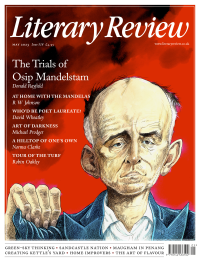Lucy Lethbridge
Doves & de Havillands
Kneelers: The Unsung Folk Art of England and Wales
By Elizabeth Bingham
Chatto & Windus 144pp £20
This is one of those delicious books that take an ostensibly small subject and illuminate a whole world. In this case it is kneelers, those embroidered padded rectangles which hang on the backs of church pews to comfort the knees of congregants at prayer. Elizabeth Bingham has been a kneeler enthusiast, she tells us, since the late 1960s, when she joined an embroidery project at the church of All Hallows by the Tower. In preparation, she sought advice from a Miss Moberly-Bell of Chelsea Old Church, ‘doyenne of the church’s needlewomen’. Kneeler history is engagingly full of formidable C of E women, and one is left marvelling at not only their stitching skills but also their mighty organisational capabilities. In the 1930s, the designer Sybil Blunt oversaw a team of eight hundred stitchers at Winchester Cathedral, including a Mistress of the Embroideries.
Nearly sixty years on, Bingham has become a renowned authority on Anglican kneelers, helping to keep the craft and traditions alive through her website (parishkneelers.co.uk). Kneelers, as she points out, are in danger of disappearing as pews are increasingly replaced by chairs, and commercial kneeler kits bring standardisation instead of local individuality.
The book, wonderfully illustrated, is a celebration of amateur skill and resourcefulness. This is real folk art, with themes of shared faith and everyday life engagingly intertwined. In kneelers spearheaded by Miss Moberly-Bell, Bingham and her fellow embroiderers created images with links to All Hallows and its congregants,

Sign Up to our newsletter
Receive free articles, highlights from the archive, news, details of prizes, and much more.@Lit_Review
Follow Literary Review on Twitter
Twitter Feed
It wasn’t until 1825 that Pepys’s diary became available for the first time. How it was eventually decrypted and published is a story of subterfuge and duplicity.
Kate Loveman tells the tale.
Kate Loveman - Publishing Pepys
Kate Loveman: Publishing Pepys
literaryreview.co.uk
Arthur Christopher Benson was a pillar of the Edwardian establishment. He was supremely well connected. As his newly published diaries reveal, he was also riotously indiscreet.
Piers Brendon compares Benson’s journals to others from the 20th century.
Piers Brendon - Land of Dopes & Tories
Piers Brendon: Land of Dopes & Tories - The Benson Diaries: Selections from the Diary of Arthur Christopher Benson by Eamon Duffy & Ronald Hyam (edd)
literaryreview.co.uk
Of the siblings Gwen and Augustus John, it is Augustus who has commanded most attention from collectors and connoisseurs.
Was he really the finer artist, asks Tanya Harrod, or is it time Gwen emerged from her brother’s shadow?
Tanya Harrod - Cut from the Same Canvas
Tanya Harrod: Cut from the Same Canvas - Artists, Siblings, Visionaries: The Lives and Loves of Gwen and Augustus John by Judith Mackrell
literaryreview.co.uk